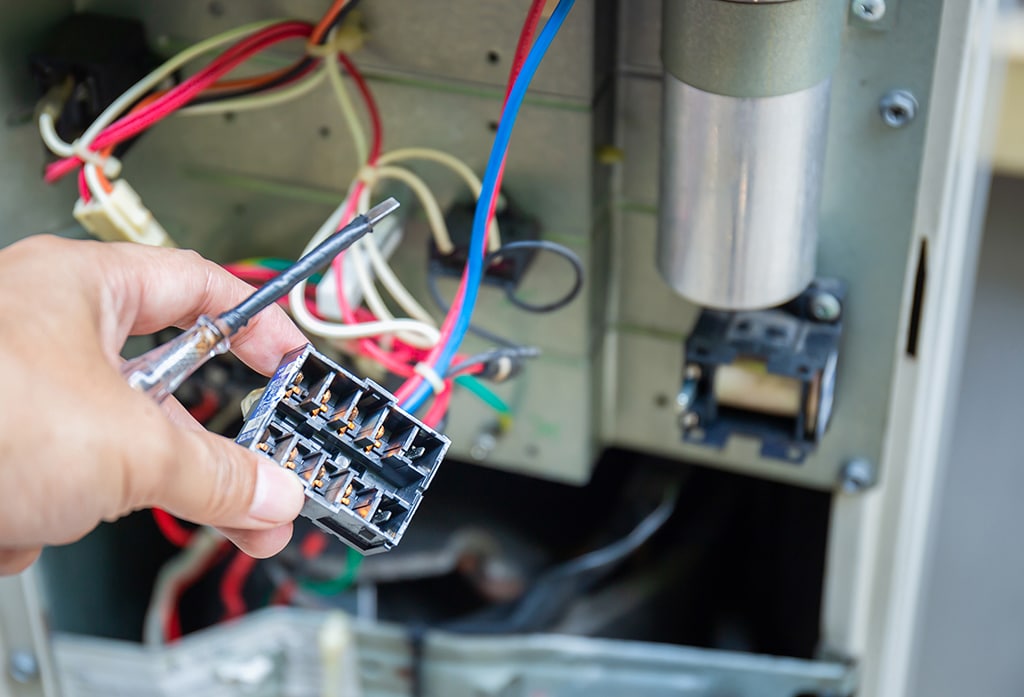
Determining Why AC Contactors Aren’t Pulling In With Your Reliable Air Conditioning Service Provider | Dallas, TX
Has your air conditioning system suddenly stopped running? Many reasons could be causing this. From insufficient refrigerant and damaged mechanical parts to faulty electrical components, damage or malfunction in one of the AC components will reduce efficiency. Sometimes, the unit might stop running overall. It’s worth noting that an air conditioner is a combination of many different components, and a fault in either of these will result in various issues. One of the electrical problems that could result in the AC not running is when the contactors aren’t pulling in. Whenever this happens, you should have an air conditioning service provider in Dallas, TX inspect the component and perform the required repairs. What is the cause for the contactors not pulling in? If you are asking yourself the same question, you are in the right place. This article will explore the main causes or reasons why AC contactors will not be pulling on. You also will learn what to do when the contactors only work when they’ve been pushed in. However, you should have an AC repair technician inspect and fix the contactor to ensure they are working properly.
What Is an AC Contactor?
It is a small device that controls the flow of electrical power to any of the components of your air conditioner. An AC contactor can be considered a drawbridge extending over the river. Whenever the draw bridge is down, the cars can drive over that bridge freely and get over to the opposite side. However, you must wait on either side of that bridge when the drawbridge is up for it to be lowered so you can cross. The contactors also work similarly. However, rather than controlling the traffic flow, they are responsible for controlling the flow of electricity. This is why an air conditioning service provider in Dallas, TX needs to replace or repair them whenever they encounter any problem. They cut off and provide power to most of your AC components, including the condenser and compressor. They also are responsible for powering your system’s different motors.
Workings of an AC Contactor
The AC contactors will be in a “UP” position whenever your AC isn’t in a cooling cycle. It means they will block the flow of electrical power into various parts of your air conditioning system. If the thermostat sends a signal to the AC to initiate a cooling cycle, the contactors receive a small voltage, telling them to drop into the “DOWN” position. This will allow electricity to flow to the different parts of the AC, allowing the system to cool the air entering your indoor space.
The contactors should remain in the down position until the thermostat set temperatures are met and a signal is to stop the cooling cycle. At this point, the contactors receive another small voltage, signaling them to open up and cut the power supply to the different parts of the AC off. Hence, any problem with the contactor will require the immediate attention of an air conditioning service provider in Dallas, TX, as it will result in your home not being properly cooled.
What Could Go Wrong with Your AC Contactor?
Burning out is the biggest problem that can befall your AC contactors. This could happen if several years of wear and tear occur because of overheating in your heating and air conditioning system. Unfortunately, if the contactors burn out, the component cannot move power to other parts of the HVAC system. Hence, it needs immediate air conditioning service. The other problem arises when the contactors are stuck in the down or up position. This could happen whenever the contactors are dirty or are wearing out. Either of these will make the AC contactors not pull in.
Reasons Your AC Contactor Isn’t Pulling In
Is your air conditioner contactor not pulling in? The first thing you should do immediately after noticing this is to call an air conditioning service provider in Dallas, TX for further inspection and repair. When they come, they will use a multimeter to check the voltage at the AC contactor coils. It will only pull in if the coils get 24V AC. So, what if the contactor gets 24V AC but still isn’t pulling in? Below are the main reasons the air conditioner contactor coils aren’t pulling in:
The Contactor Coil Isn’t Receiving Any Voltage
As explained above, the thermostat sends a small voltage to the contactor to start the cooling cycle. If the contactor doesn’t receive the 24V AC from the thermostat, it won’t pull in. meaning that it won’t start, necessitating the attention of an air conditioning service provider. Ultimately, the voltage for your contactor coils comes from the control board. In many residential air conditioning systems, the voltage will follow the path below to the contactor:
- It flows from the R terminal on the AC or HVAC control board.
- It then enters the Rc terminal of your thermostat.
- The power then enters the Y terminal of the thermostat and that of the control board
- The power then reaches the AC contactor coils
It means that should the path between either of the connections above be broken, the AC contactors will not pull in. Hence, the air conditioning service provider must check these connections when they come to inspect the contactors and during the maintenance visit. However, some air conditioning systems also feature float switches wired to the contactor.
In such cases, the float switch is often wired or installed between the thermostat’s R terminal and the R terminal of the air handler. Alternatively, the float switch might be wired between your AC control board’s Y terminal and the thermostat’s Y terminal. Hence, you should have the issue inspected by an air conditioning service provider because they know where to inspect and target when repairing your unit.
Whenever the Condensate Switch Has Been Triggered
Your air conditioner’s condensate drain pan or drain pipe will not allow the contactors to pull in if they are clogged, which will cause the condensate overflow switch to be triggered. Have you recently had an air conditioning service provider in Dallas, TX inspect the condensate drains for clogs and other issues? If you haven’t, then you should. The cable that leads to your air conditioning contactor and the condensate overflow switch is sometimes connected in a series connection. Therefore, if your overflow switch trips, the power to your air conditioning contactor will be switched off. If the condensate drain pan or pipe attached to your air conditioner is full of water, you should enlist the help of an air conditioning service provider to remove the clog from the drain pan or the condensate drain.
Loose Wiring Connections
Are the wiring connections of your air conditioning contactors loose? Then that will make the contactors fail to pull in. Fortunately, you can avoid this problem by hiring an air conditioning service provider to inspect and service the AC regularly. Part of routine air conditioning service is inspecting the wiring connections and fastening them if loose. If the contactor connections aren’t tight, the coils will not get power, and the contactor will not be able to pull in.
The other problem that could arise from losing connections is chattering. This happens whenever the contactor engages rapidly and disengages rapidly, similar to a machine gun. This is a problem that requires the immediate attention of an air conditioning service provider. If the contactor coils chatter, the AC repair pro will check for loose connections on the terminals of the contactor coils. Should the connections be loose, they could result in intermittent connections that make the contactors chatter.
Whenever the Contactor Coils Are Burnt Out
Does the contactor coil have a voltage but isn’t pulling in? That is a surefire sign that it is burnt out. This problem will need immediate AC repairs because the unit cannot operate if the contactors are burned out. The coils are the component of the contactor that provides the force that pulls the contacts in. If the coils are energized, they produce a magnetic field that pulls the contactor’s moving core in. This enables the system to be powered and cool your home.
They will only pull in if the contactors are fixed or burned out. So, how does an air conditioning service provider in Dallas, TX determine that the contactors are burned? The most effective method is conducting an Ohm test. This involves turning off the power to the furnace or air conditioner and the condensing unit of the AC. The technician then opens the electrical enclosure at the side of the air conditioner’s condensing unit. Contactor coil terminals are normally installed on the right and left sides of the Ac contactor. When the wires are exposed, the air conditioning service provider turns on the multimeter and sets it to Ohms. They will then measure the resistance across the air conditioning contactor coils.
If the contactor coils are all right, they will have a resistance of 10-20 Ohms. On the other hand, the coils will have a low resistance if burned. Their measure of resistance will usually be below 5 Ohms. The technician recommends replacing them in such a case, as repairs are usually impossible. Hence, a routine air conditioning service is critical as it can uncover issues like burning contactors and take the required measures to prevent this.
Pitted or Corroded Contacts
Are the contacts of your AC contactors pitted or corroded? They will only make a good electrical connection when they pull in. Your air conditioner will not turn on as the power is not reaching all the components. Pitting of contacts happens to AC contactors every time. It is caused by the electrical arcs whenever the contactor disengages and engages. The electrical arch creates pitting corrosion on the AC contacts, increasing the resistance in the electrical connections.
In due time, the contacts will become pitted to the point where electricity cannot flow through the contactor, rendering your air conditioner inoperable. It is highly recommended that an air conditioning service provider replace your contactor in its whole if it has pitted or corroded contacts. It is typically not too much of a hassle to change a contactor because they are not too expensive and are simple enough.
Some people will suggest using contact cleaner to clear out the contacts. Because it typically causes more problems than it solves, cleaning your contacts with a contact cleaner is something only some technicians would advocate. Cleaning the area between the contacts is difficult because it is quite confined. Because the contacts on many modern contactors are not even exposed, it is necessary to disassemble the entire device to reach the contacts inside. At this time, the contactor could be replaced with a new one.
The Contactors Only Work When They Are Pushed In
If the contactor will only work when it’s pushed in, it isn’t getting enough voltage supply from the thermostat. It could also mean that the float switch has been triggered. Your thermostat turns on your AC contactor. It may be faulty if your thermostat doesn’t “click” when cooling. Condensate overflow is another possibility. Your air conditioner’s contactor will work only manually if your condensate overflow switch activates. If the high or low-pressure switch in the AC unit trips, your contactor may only operate when pushed in. High and low-pressure switches safeguard your AC compressor from coolant pressures outside its operational zone. If your AC unit’s refrigerant pressure fluctuates, the high or low-pressure switch may trip and reduce power to the contactor. Whenever this happens, it is wise to have the system inspected by an air conditioning service provider near you in Dallas, TX.
Ensure the Contactors Are Inspected During the Air conditioning Service
Maintenance of your air conditioner is critical for its continued operation. However, some components, like the contactors, may be forgotten. Contact us today at One Hour Air Conditioning & Heating of Dallas for a thorough inspection and maintenance service.





